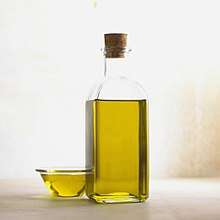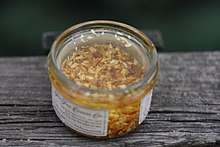Garlic oil

Garlic oil is the volatile oil (essential oil) derived from garlic.[1][2][3] It is usually prepared using steam distillation, and can also be produced via distillation using ether. It is used in cooking and as a seasoning, a nutritional supplement, and also as an insecticide.
Preparation
Garlic oil is typically prepared using steam distillation, whereby crushed garlic is steamed with the resultant condensation containing the oil.[1] Garlic oil contains volatile sulfur compounds such as diallyl disulfide, which is the "most abundant constituent" of essential garlic oil.[1][4][5][6] Steam-distilled garlic oil typically has a pungent odor and a yellow-brownish coloration.[5] Its odor has been attributed to the presence of diallyl disulfide.[5] To produce around 1 g of pure steam-distilled garlic oil, around 500 g garlic is required.[1] Steam-distilled garlic oil has around 900 times the strength of fresh garlic, and around 200 times the strength of dehydrated garlic.[5]
Ether can also be used to extract garlic oil.[1] A type of garlic oil involves soaking diced or crushed garlic in vegetable oil, but this is not pure garlic oil; rather it is a garlic-infused oil.[1]
Uses
Garlic oil is used as a nutritional supplement, and is sometimes purveyed in the form of capsules, which may be diluted with other ingredients.[1][5] Some commercial preparations are produced with various levels of dilution, such as a preparation that contains 10% garlic oil.[5] Herbal folklore holds that garlic oil has antifungal and antibiotic properties,[2] but there is no high-quality clinical research to indicate such effects exist. It is also purveyed in health food stores as a digestive aid.[7]
It can also be used as an insecticide, whereby it is diluted with water and sprayed on plants.[2][8]
Stabilized garlic flavor blend is a proprietary mixture of dehydrated garlic powder infused with garlic oil, which increases the flavor of the garlic powder.[9]
Garlic-flavored oil

Garlic-flavored oil is produced and used for cooking and seasoning purposes, and is sometimes used as an ingredient in seasoning mixtures.[1][5] This differs from essential garlic oil, and typically involves the use of chopped, macerated or crushed garlic placed in various vegetable oils to flavor the oil.
See also
- Garlic sauce
- List of essential oils
- List of garlic dishes
- Theodor Wertheim – performed studies about garlic oil
References
- 1 2 3 4 5 6 7 8 Stanway, P. (2012). The Miracle of Garlic: Practical Tips for Health & Home. Watkins Media. p. 25. ISBN 978-1-78028-607-5. Retrieved December 29, 2017.
- 1 2 3 Ellis, B.W.; Bradley, F.M.; Atthowe, H. (1996). The Organic Gardener's Handbook of Natural Insect and Disease Control: A Complete Problem-Solving Guide to Keeping Your Garden and Yard Healthy Without Chemicals. Rodale Books. p. 473. ISBN 978-0-87596-753-0. Retrieved December 29, 2017.
- ↑ Singhal, R.; Kulkarni, P.R.; Rege, D.V. (1997). Handbook of Indices of Food Quality and Authenticity. Woodhead Publishing Series in Food Science, Technology and Nutrition Series. Taylor & Francis. p. 403. ISBN 978-1-85573-299-5. Retrieved December 29, 2017.
- ↑ Mckenna, D.J.; Jones, K.; Hughes, K.; Tyler, V.M. (2012). Botanical Medicines: The Desk Reference for Major Herbal Supplements, Second Edition. Taylor & Francis. p. 377. ISBN 978-1-136-39363-1. Retrieved December 29, 2017.
- 1 2 3 4 5 6 7 Farrell, K.T. (1998). Spices, Condiments and Seasonings. Chapman & Hall food science book. Springer US. p. 101. ISBN 978-0-8342-1337-1. Retrieved December 29, 2017.
- ↑ Linskens, H.F.; Adams, R.P.; Crespo, M.E.; Jackson, J.F.; Deans, S.G.; Dobson, H.E.M.; Dunlop, P.; Erdelmeier, C.A.J.; Ghosh, A.; Hammond, E.G. (2012). Essential Oils and Waxes. Molecular Methods of Plant Analysis. Springer Berlin Heidelberg. p. 105. ISBN 978-3-642-84023-4. Retrieved December 29, 2017.
- ↑ Rosenbaum, M.D. (1990). Editorial Research Reports, 1989. CQ RESEARCHER. Cq Press. p. 778. ISBN 978-0-87187-552-5. Retrieved December 29, 2017.
- ↑ Baser, K.H.C.; Buchbauer, G. (2015). Handbook of Essential Oils: Science, Technology, and Applications, Second Edition. CRC Press. p. 659. ISBN 978-1-4665-9047-2. Retrieved December 29, 2017.
- ↑ Indian Spices. Spices Export Promotion Council. 1996. p. 46. Retrieved December 29, 2017.
Further reading
- Berthold, Heiner K.; Sudhop, Thomas; Bergmann, Klaus von (June 17, 1998). "Effect of a Garlic Oil Preparation on Serum Lipoproteins and Cholesterol Metabolism". JAMA. 279 (23): 1900–1902. doi:10.1001/jama.279.23.1900. ISSN 0098-7484. Retrieved December 29, 2017.
- "Allylsulfide constituents of garlic volatile oil as antimicrobial agents". Phytomedicine. 7 (3): 239–243. May 1, 2000. doi:10.1016/S0944-7113(00)80010-0. ISSN 0944-7113. Retrieved December 29, 2017.
- Ross, Z. M.; O'Gara, E. A.; Hill, D. J.; Sleightholme, H. V.; Maslin, D. J. (December 1, 2000). "Antimicrobial Properties of Garlic Oil against Human Enteric Bacteria: Evaluation of Methodologies and Comparisons with Garlic Oil Sulfides and Garlic Powder". Applied and Environmental Microbiology. 67 (1): 475–480. doi:10.1128/AEM.67.1.475-480.2001. ISSN 0099-2240. PMC 92605. PMID 11133485. Retrieved December 29, 2017.
- "Effect of Garlic Oil and Four of its Compounds on Rumen Microbial Fermentation". Journal of Dairy Science. 88 (12): 4393–4404. November 1, 2005. doi:10.3168/jds.S0022-0302(05)73126-X. ISSN 0022-0302. Retrieved December 29, 2017.
.jpg)